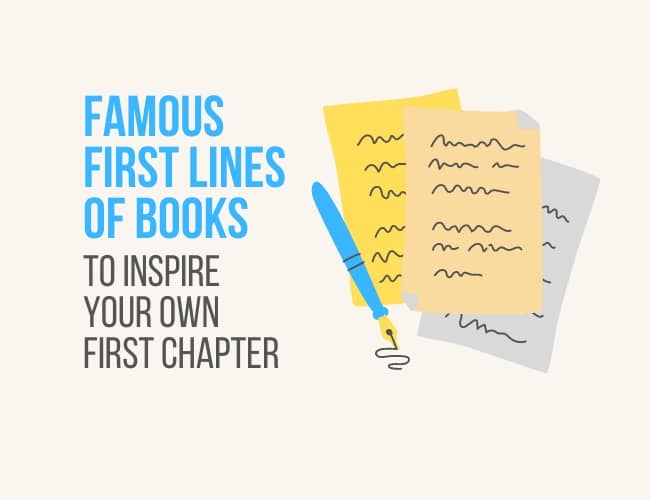First impressions are important, and no more so than when you pick up a book! Today we look at the famous first lines of books that have captured readers for years to see what we can learn about how to make the best first impression.

Today we welcome guest author E.Q. Adair who recently shared in our workshop about the process she used to improve her own first lines and chapters. Welcome, E.Q.!
You never get a second chance to make a good first impression. Why? Because we are biologically hard-wired to quickly discern friend from foe in a first encounter. We instantly decide if flight or fight is the correct response to keep us safe. Is that wild animal likely to eat me? Does that stranger have a threatening weapon?
Neuroscientists at NYU and Harvard have identified the specific brain mechanisms responsible for forming our snap first impressions. In one article, they stated, “People make relatively accurate and persistent evaluations in under half a minute.”
Half a minute.
If people devote fewer than thirty scant seconds evaluating another human being, how long are they likely to give your novel?
The power of a first impression
Think back to your last trip to your local library or bookstore. Which books did you pick up? How much time did you allow each one? And more importantly, how many did you take home and read?
We browse in our digital world as well. The Kindle “Send Free Sample” feature provides an exact maximum figure of how much of your book someone will read before deciding whether or not to buy it: 10%.
Your first chapter is your book’s first impression, and you only get one shot to capture the reader’s attention with intriguing questions they must learn the answers to, compelling them to keep reading.
Book covers, of course, also grab readers’ attention. But how many times have you bought a book based solely on its cover without peaking inside? Agents and publishers aren’t swayed by covers when they decide to publish your work.
I don’t know about you, but when I search for a new read on Amazon or The Book Depository, I’m much more interested in the number of reviews and stars than the tiny cover thumbnails.
How do you make a great first impression?
Well-written first chapters follow the 7 Steps to Write a Good First Chapter. A great first chapter makes it impossible for readers to imagine not finishing the book, transfixes with specific nuance. To review that post, it will include:
- An active opening scene
- Introduction to the protagonist (one we sympathize with!)
- Establish the point-of-view
- Set the genre
- Clarify the value scale
- Establish the stakes
- Follow a structure with the six elements of storytelling
The Perfect First Line of a Novel establishes readers’ expectations and instills curiosity and connection.
How do you as an author begin a tantalizing trail of breadcrumbs, hinting at alternative universes and haunting events?
Details. Truly great authors invent an impression of space and time through the thousands of details we all absorb every day without registering them. But we notice.
A look at the masters: famous first lines of books
In preparation for tackling the all important first chapter of my third edit, I read twelve first chapters of books I admire. I raided my bookshelves and Kindle.
Below are the scribbled words and phrases that captured my imagination, and the book titles. Some are first lines, others are from the first chapter. Extra credit if you can identify the following lines with the correct book or author. (Answers below.)
1. “It’s not the killing, that’s not the thing.”
Hinting at more than one killing creates immediate conflict. Part of me doesn’t want to know, but the rest of me is curious, and I read on. It prompts the question: if killing's not the thing, what is?
2. “He lay flat on the brown, pine-needled floor of the forest, his chin on his folded arms, and high overhead the wind blew in the tops of the pine trees.”
Coupled with the famous title, this line solidifies the reader’s relationship with the narrator. We’re invested in his fate from the first sentence wondering if he's going to make it out alive, even in this idyllic setting.
3. “It was a pleasure to burn.”
My mind races after reading these six words. Fire and pleasure create an instant, strong impression, and makes me wonder who this character is who likes burning things?
4. “In my younger and more vulnerable years my father gave me some advice that I’ve been turning over in my mind ever since.”
The first sentence introduces conflict. Should the narrator have followed his father’s advice, or is he filled with regret that he did so at the expense of his own dreams?
5. “The snow in the mountains was melting and Bunny had been dead several weeks before we came to understand the gravity of our situation.”
A dead body in the first sentence drops us into the action. Who is Bunny and did her death cause the grave situation, or the other way around?
6. “Mother died today. Or maybe, yesterday; I can’t be sure.”
So many questions raised in the first ten words. The narrator’s relationship with his mother is fraught with drama and friction.
Captivating lines in first chapters
7. “An unnerving mirror hung at the end of a corridor next to misleading encyclopedias.”
One of my all-time favorite sentences because of its lyrical language and introduction to a world that is not our own. Misleading encyclopedias also suggest injustice.
8. “A narrow alleyway, more of a scar than a street.”
Reading this line, I imagine the narrator squeezing between buildings in a jammed-packed city to avoid someone, or access a secret door to a clandestine location. A strong, relatable impression forms, transporting the reader.
9. “Babbles of voices from coffeehouses and bars.”
Recognizable sounds provide a frame of reference. The reader understands an entire setting from seven succinct words.
10. “Weak minds wait for others to solve problems.”
This sentence appeals to our egos — who doesn’t want a stronger mind, better able to solve problems? It’s also concise — every word is essential.
11. “Elemental details of magnificent, paradoxical wines.”
Wine can be intimidating. The author promises to unravel mystery.
12. “Lilies leaning so palely from their waisted cut-glass vase.”
I love this image and poetic combination of words. This sentence paints a picture of the characters’ world, pulling us into it alongside them.
Check your answers here to see how many you recognized!
- The Anomaly by Hervé Le Tellier
- For Whom The Bell Tolls by Ernest Hemingway
- Fahrenheit 451 by Ray Bradbury
- The Great Gatsby by F. Scott Fitzgerald
- The Secret History by Donna Tartt
- The Outsider by Albert Camus
- The Library of Babel by Jorge Luis Borges
- The Shadow of the Wind by Carlos Ruiz Zafón
- Palace Walk by Naguib Nahouz
- Chess is Child’s Play by Laura Sherman and Bill Kilpatrick
- The Wine Bible by Karen MacNeil
- All the Pretty Horses by Cormac McCarthy
Study your favorite first impressions
Even if you didn't know any of those lines in literature, you can follow the process I used to identify the lines that capture your attention as a reader. Or study the examples in this article to see what is interesting about the structure, specificity, or conflict inherent in each.
Here are a few more famous first lines of books:
“I write this sitting in the kitchen sink.” Dodie Smith, I Capture the Castle
“Many years later, as he faced the firing squad, Colonel Aureliano Buendía was to remember that distant afternoon when his father took him to discover ice.” Gabriel Garcia Marquez, One Hundred Years of Solitude
“It is a truth universally acknowledged, that a single man in possession of a good fortune, must be in want of a wife.” Jane Austen, Pride and Prejudice
“No live organism can continue for long to exist sanely under conditions of absolute reality; even larks and katydids are supposed, by some, to dream.” Shirley Jackson, Haunting of Hill House
“Happy families are all alike; every unhappy family is unhappy in its own way.” Leo Tolstoy, Anna Karenina
“Whether I shall turn out to be the hero of my own life, or whether that station will be held by anybody else, these pages must show.” Charles Dickens, David Copperfield
“If you really want to hear about it, the first thing you’ll probably want to know is where I was born, and what my lousy childhood was like, and how my parents were occupied and all before they had me, and all that David Copperfield kind of crap, but I don’t feel like going into it, if you want to know the truth.” J. D. Salinger, The Catcher in the Rye
And who could forget the opening to Sylvia Plath's The Bell Jar: “It was a queer, sultry summer, the summer they electrocuted the Rosenbergs, and I didn't know what I was doing in New York.“
Now you try
Don't feel like you have to limit yourself to serious literary works. Look at the books in genres you love most, whether it's Harry Potter or The Color Purple or a hulking tome by Fyodor Dostoyevsky.
Skimming through the first lines and chapters is an opportunity to learn from the best. How did James Joyce, Isabel Allende, Kurt Vonnegut, or Gabriel Garcia Marquez write their novels’ first impression? It’s easier than ever to scour first chapters, gleaning clues of the craft of the authors we admire.
Start a book list—preferably one in your genre. Then spend a summer afternoon of spare time at a library, a morning coffee browsing at a bookstore, or click Send Free Sample to browse hundreds of first chapters in a relatively short space of time.
Raid your own bookshelves or reading device—you have those favorite books for a reason. Immerse yourself in first chapters and decide how you want to present your book’s first impression.
Remember, your goal is not to be Erin Morgenstern or Franz Kafka or Zora Neale Hurston. Your goal is to see how they created those first impressions that grabbed the reader's heart and emotions and wouldn't let go, so you can use similar techniques.
What books immediately come to mind when you think of memorable first impressions? Share in the comments.
PRACTICE
Skim three (at least!) first chapters of books in your genre. List three details from each book, be it a description of a shadow on a sidewalk, a side character’s nasal laugh, or the smell of burning beeswax candles.
What captured your attention, or caused you to close the book and move on to another? How did the author communicate the setting? What about the protagonist enticed you to want to follow his or her journey? If you write non-fiction, what fact or anecdote intrigued you enough to want to learn more?
Go back and review a first chapter you have written, or if you haven’t written a first chapter yet, write a new one. Imagine the small, layering details of the world you’re creating in your book and add them to your work.
Spend 15 minutes writing, then share your answers in the Pro Practice Workshop here. And don’t forget to leave feedback for your fellow writers!
Not a member yet? Join us here!
This article is by a guest blogger. Would you like to write for The Write Practice? Check out our guest post guidelines.



0 Comments